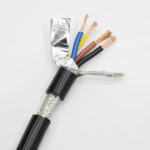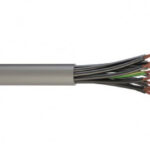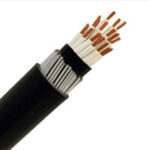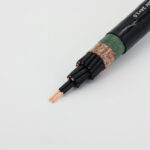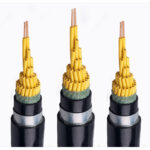High Voltage (HV) and Extra High Voltage (EHV) cables are the lifelines of modern electrical infrastructure. From cross-country transmission to offshore wind farms, these cables ensure stable and efficient power delivery over long distances and harsh terrains. Behind these complex systems stand a few elite manufacturers who combine cutting-edge engineering, stringent quality control, and decades of experience.

high voltage cable manufacturers
If you're planning a grid expansion, renewable energy integration, or high-capacity transmission project, choosing the right high voltage cable manufacturer is critical. This guide highlights the top global players in HV cable manufacturing, the criteria for evaluation, and insights into the industry's future.
What Are High Voltage Cables?
High voltage cables are typically designed for voltages above 35 kV and can reach up to 800 kV for AC or ±640 kV for DC systems. They serve as the backbone of power transmission, bridging the gap between generation plants and substations or urban centers.
HVAC (High Voltage Alternating Current): Common in overhead and underground grid transmission.
HVDC (High Voltage Direct Current): Ideal for long-distance, high-efficiency, and submarine links.
What Defines a Top High Voltage Cable Manufacturer?
1. Expertise & Proven Track Record
Decades of experience in HV and EHV projects.
Turnkey solutions: from design and manufacturing to installation and testing.
Participation in landmark projects like intercontinental interconnects and offshore wind grids.
2. Advanced Production & Quality Control
Extrusion towers for concentric insulation.
Ultra-clean production environments.
In-house labs for full-scale testing: partial discharge, impulse, AC/DC withstand.
3. Comprehensive Product Portfolio
HVAC cables: Up to 550 kV XLPE.
HVDC cables: MI and XLPE up to ±640 kV.
Submarine, underground, overhead, armored options.
Custom sheath materials for oil, fire, chemical, or UV resistance.
4. Global Service & Logistics
Worldwide manufacturing and warehousing.
Project logistics, emergency support, and technical training.
5. Innovation & Sustainability
Green production practices (ISO 14001).
Smart cables with built-in sensing and fiber optics.
R&D in superconducting and modular cable systems.
Top High Voltage Cable Manufacturers (Global Profiles)
1. Prysmian Group (Italy)
Global Reach: Over 50 countries.
Specialties: HVDC submarine cables, turnkey EPC solutions.
Projects: Viking Link (UK–Denmark), German Corridor.
Certifications: ISO 9001, ISO 14001, IEC 62067, IEC 60840.
2. Nexans SA (France)
Expertise: Renewable energy and subsea interconnectors.
Innovation: XLPE cables for ±525 kV DC, digital twin technology.
Notable Projects: Crete-Attica interconnector, NordLink.
Sustainability: Science-based targets for carbon neutrality.
3. NKT A/S (Denmark)
Focus: Green transmission, Nordic grid upgrades.
Capabilities: ±640 kV DC XLPE cables, turnkey project execution.
Highlight: COBRAcable (Netherlands–Denmark).
R&D: Superconducting cable development.
4. Sumitomo Electric Industries (Japan)
Strengths: Long track record in Asia-Pacific and EHV R&D.
Specialization: HVDC land and submarine links.
Innovation: Flexible HV cable joints, high-strength insulation.
5. LS Cable & System (South Korea)
Global Footprint: Asia, Middle East, North America.
Key Markets: Utilities, renewables, smart grids.
Edge: HVDC XLPE submarine cable manufacturing.
6. Southwire Company LLC (USA)
Core Focus: North American grid infrastructure.
Products: HV and EHV transmission cables, overhead conductors.
Reputation: Strong U.S. utility presence, responsive support.
7. Furukawa Electric (Japan)
Niche: Environmentally friendly cables, EHV underground.
Experience: More than a century in electrical transmission.
Applications of High Voltage Cables
Utility Interconnections: National and cross-border power links.
Offshore Wind Farms: Connecting turbines to grid substations.
Large Industrial Loads: Supplying smelters, chemical plants.
Urban Networks: Undergrounding for space and safety.
Renewable Energy: Solar and hydro grid integration.
High Voltage Cable Construction (Typical Design)
| Component | Function |
|---|---|
| Conductor | Copper/Aluminum; large, compacted cross-sections |
| Conductor Screen | Ensures field uniformity |
| Insulation | XLPE, EPR, MI – high dielectric performance |
| Insulation Screen | Prevents corona discharge |
| Metallic Sheath | Grounding, shielding, fault current path |
| Armour | Mechanical protection (for burial/submarine) |
| Outer Sheath | UV, fire, water, chemical resistance |
Emerging Trends in HV Cable Technology
Higher Voltages: Reaching ±640 kV DC and 800 kV AC.
Smart Cables: Fiber optic sensing, thermal monitoring.
Superconducting Cables: Low-loss, high-capacity transmission.
Eco-Friendly Materials: Recyclable sheathing, halogen-free options.
Modular Systems: Quicker deployment, simplified maintenance.
Conclusion
High voltage cable systems are critical infrastructure that demands world-class engineering and manufacturing. Whether you're building an offshore wind farm or upgrading a national grid, the success of your project hinges on partnering with a top-tier HV cable manufacturer.
By using the insights and profiles in this guide, you can make informed, strategic decisions for your transmission needs—ensuring safety, efficiency, and long-term reliability.

